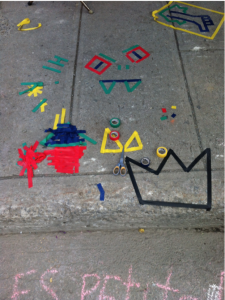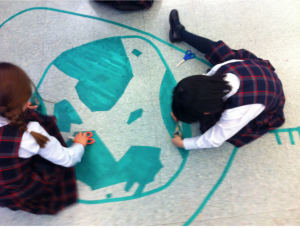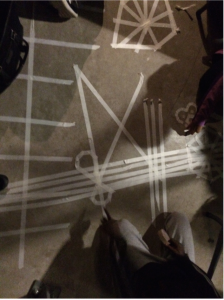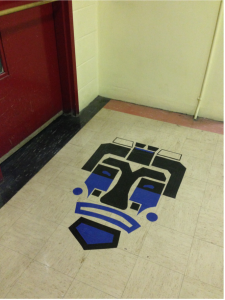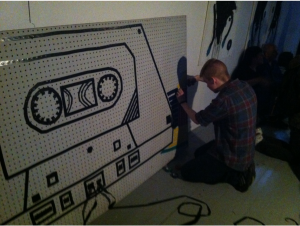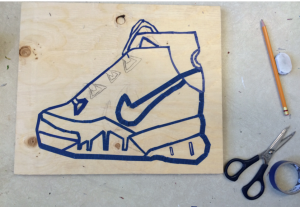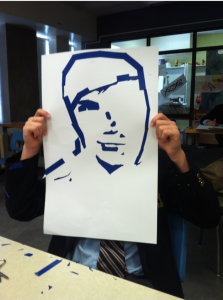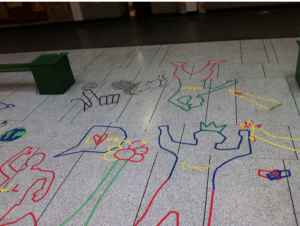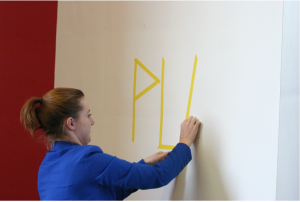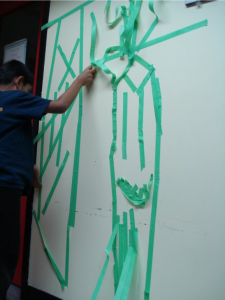

“Mixed Tape” Ephemeral installation and facilitation of tape art at Emergence Symposium, Toronto, November 2015 (Photo: M. Proietti)
Christina Marie Phelps
5th year, Art Education Specialization
Tape Art: Getting into Sticky Situations
tape on walls and other objects
What if you were asked to draw a picture without the use of a pencil, crayon or ink? What if you were discouraged from making your marks on a traditional piece of paper or canvas support? These are the types of questions I ask of my various learning populations when encountering the medium of tape art. Tape art is a drawing medium and an artful “ playshop” activity that I like to use as an icebreaker and introductory activity with various teaching populations. This ephemeral and site-specific improvisational art form is an excellent entry point into the world of street art practices, murals, and public artworks. I have used the medium of tape art as a teaching tool for the past four years in public and private school settings, university workshops, arts festivals, symposiums, and with church and community groups. I’ve found that tape art workshops can bring incredible results, because of the playful medium being used.
Inspiration: I first came across an artist who uses tape art, while developing a community art project for the “ Artful Play” unit in my second year of studies at Concordia University. Buff Diss, the Australian graffiti writer-turned-tape artist, had explored the medium in the same way he had with aerosol paint. Buff Diss’s tape art installations can be found on train cars, busy market streets, in abandoned buildings, and on sides of walls, both in interior and exterior spaces. After seeing how Diss works the possibilities of the medium, I was hooked. Low adhesive tape like a green or blue painter’s tape seems to be the perfect kind of tape since it allows participants to tear, snip, and place their tape-drawn creations quickly and easily. I will often give learning groups the option to create solo works or to pair up and work collectively on a themed creation. The latter situation has lead to some interesting conversations regarding co-operation, negotiating space, and creative problem solving. The ephemeral nature of tape—it can be peeled off, or else it eventually wears away—allows the artist to create and experiment in environments that are normally left quite blank. Like chalk on a playground, tape is a way for people to temporarily reclaim the public space and make their mark for others to see and interact with.
Tape-Testing: Besides typical painter’s tape, I have worked with colored electrical tape on surfaces that have a dull finish such as sidewalks, streets, brick walls, and table-tops that have protective coating. The main differences between this tape and painter’s masking tape are the thickness, the fact that it has to be cut with scissors or a knife, and the limit that it should not be used on a painted surface. Electrical tape has a tendency to pull off the paint from walls, or destroy certain finishes on floors and table-tops. It’s always best to test the tape prior to the playshop and get permission from the building manager. The new decorative paper tapes and washi tapes are deemed safe to use on walls and floors but paper tapes tear quite easily if walked on. Also, washi tape can be quite costly and there are limited amounts on a roll.
Tear Down: When working in a shared common space, it’s important to leave the space as found. That means the tape art installations don’t remain for longer than the duration of the playshop. I actually have the tear-down segment become a major part of the activity. After presentation and discussion of the artworks created, I challenge my groups to remove and collect their tape into a giant tape ball, that they are then encouraged to play with afterwards. This is especially wonderful when orchestrating the activity in children’s groups. Once their artworks have been documented, they get to make a unique tape ball which becomes a souvenir of their non-conventional drawing experience.
Resources:

